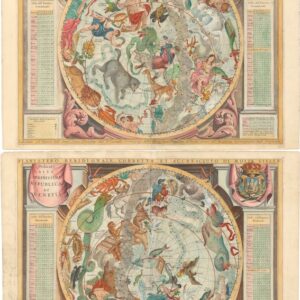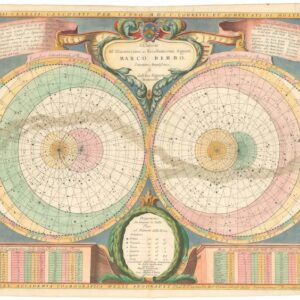A splendid mid-19th century Celestial Planisphere from Italy.
PLANISFERO CELESTE. Contenente le principali stelle visibili ad occhino nudo.
$975
1 in stock
Description
This Italian chart of the heavens, or “celestial planisphere” in stellar cartography, was designed to visualize the stars, galaxies, and other cosmological phenomena visible to the naked eye. Produced in Milan around 1850 and printed as a monumental and vibrant color lithograph, this chart was designed to bring the mysteries of the universe into lecture halls of schools and universities throughout Italy. It consists of two large and adjoining sheets, each depicting a hemisphere and several astronomical vignettes.
Leading astronomers compiled the chart at observatories in Rome and Milano, and an astronomical educator, Ernesto Sergent-Marceau, crafted the final product. The two circular projections are akin to a double hemisphere world map. On the left, we have the Austral or Southern Hemisphere, while on the right, we find the Boreal or Northern Hemisphere. Each planisphere includes a device for indicating what part or parts of a given location is visible at a given time. On the star chart itself, we see many black blobs indicating stars or other heavenly bodies. The black spots vary in size depending on their distance from the Earth and their visibility in the night sky.
Below both planispheres are three colored vignettes conveying either significant and observable celestial phenomena or concepts meant to assist the audience in grasping the enormity of what was being conveyed in this large chart. Thus, in the first vignette from the left, we see an imaginary rendition of our planet from space. Juxtaposing this on the right side of the left planisphere is an artistic rendition of the ‘splendid’ Orion Nebula. The right sheet’s planisphere is borne in the same manner, only here, the three vignettes depict our solar system on the left, followed by an image of three comets observed in the 18th century. To the right, we see a representation of the strange phenomenon of zodiacal light (i.e. a faint, diffuse, and roughly triangular white glow visible in the night sky and appearing to extend from the Sun).
Cartographer(s):
Ernesto Sergent-Marceau (d. February 12, 1895) was an Italian astronomer and stellar cartographer with a particular devotion to meteorology. In 1855, he entered the Specola in Milan as a “free pupil” and within the following decade he rose in the academic ranks to become an Adjunct Astronomer in 1866. Both leading up to this appointment, and in the years following it, Sergent-Marceau worked for extended periods at the Astronomical Observatory of Brera in Milan, including in their extensive astronomical archive. In 1872, Sergent-Marceau left the Specola to teach in Bari.
Throughout his life, Sergent-Marceau was an ardent astronomer and educator. Among his professional activities, he served as editor for the publication Astronomical Ephemerides of Milan from 1857 to 1872.
Condition Description
Various blemishes and expert repairs. Very good.
References



